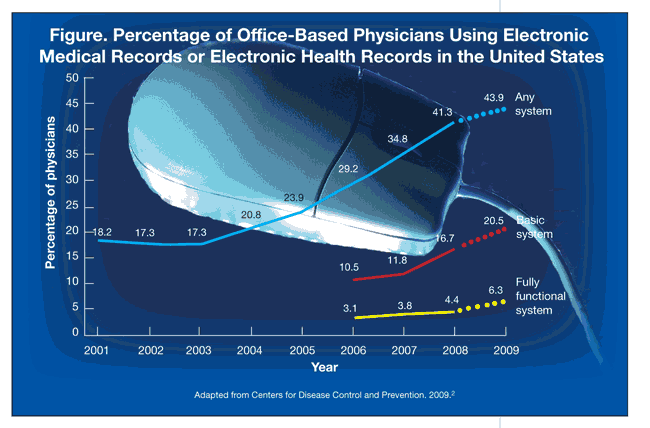- CDC
- Heart Failure
- Cardiovascular Clinical Consult
- Adult Immunization
- Hepatic Disease
- Rare Disorders
- Pediatric Immunization
- Implementing The Topcon Ocular Telehealth Platform
- Weight Management
- Screening
- Monkeypox
- Guidelines
- Men's Health
- Psychiatry
- Allergy
- Nutrition
- Women's Health
- Cardiology
- Substance Use
- Pediatrics
- Kidney Disease
- Genetics
- Complimentary & Alternative Medicine
- Dermatology
- Endocrinology
- Oral Medicine
- Otorhinolaryngologic Diseases
- Pain
- Gastrointestinal Disorders
- Geriatrics
- Infection
- Musculoskeletal Disorders
- Obesity
- Rheumatology
- Technology
- Cancer
- Nephrology
- Anemia
- Neurology
- Pulmonology
Electronic Medical Records: Functionality Misses the Mark in Coordination of Care
Although policymakers continue to push for greater adoption of electronic medical records (EMRs), physicians already using these systems report difficulty in exchanging data because of program interoperability, according to a new report.1 “We found that many aspects of the EMRs are helpful for coordination of care delivered within the physician’s office,” said Ann S. O’Malley, MD, MPH, lead study author and senior researcher at the Center for Studying Health System Change, in an interview with Drug Benefit Trends. “But there are areas for both office care processes and EMR design to evolve in order for EMRs to better support coordination tasks.”
Although policymakers continue to push for greater adoption of electronic medical records (EMRs), physicians already using these systems report difficulty in exchanging data because of program interoperability, according to a new report.1 “We found that many aspects of the EMRs are helpful for coordination of care delivered within the physician’s office,” said Ann S. O’Malley, MD, MPH, lead study author and senior researcher at the Center for Studying Health System Change, in an interview with Drug Benefit Trends. “But there are areas for both office care processes and EMR design to evolve in order for EMRs to better support coordination tasks.”
Although policymakers continue to push for greater adoption of electronic medical records (EMRs), physicians already using these systems report difficulty in exchanging data because of program interoperability, according to a new report.1 “We found that many aspects of the EMRs are helpful for coordination of care delivered within the physician’s office,” said Ann S. O’Malley, MD, MPH, lead study author and senior researcher at the Center for Studying Health System Change, in an interview with Drug Benefit Trends. “But there are areas for both office care processes and EMR design to evolve in order for EMRs to better support coordination tasks.”
Her team sought to examine ways physicians use commercial EMRs to support coordination tasks as well as identify associated work-around practices. Sixty professionals were interviewed, including physicians or staff from 26 practices that had been using commercial ambulatory care EMRs for at least 2 years. In addition, chief medical officers at EMR vendors and thought leaders were included.
EMRs were shown to help in the coordination of intra-office care, such as allowing providers to access patient data during visits as well as providing electronic messaging. However, because EMR systems lack standardized design and key data elements, physicians found it difficult to use these programs to coordinate patient care between practices. In addition, EMRs are currently designed to meet billing and documentation needs, not patient and provider needs for clinical management.

A recent study released by the CDC showed that more than 40% of all office-based or clinic-based physicians use an EMR or electronic health record (EHR) system (Figure).2 About 20.5% of respondents reported having an EMR or EHR system meeting the criteria of a basic system and 6.3% had a fully functional system.
“To improve EMRs, thus improving coordination of care, policymakers could expand current health information technology policies to support assessment of how well the technology facilitates tasks necessary for coordination,” said O’Malley. “By reforming payment policy to include care coordination, policymakers could encourage the evolution of EMR technology to include capabilities that support coordination, for example, allowing for interpractice data exchange and multiprovider clinical decision support.”
References:
References
1. O’Malley AS, Grossman JM, Cohen GR, et al. Are electronic medical records helpful for care coordination? Experiences of physician practices. J Gen Intern Med. 2009 Dec 22; [Epub ahead of print].
2. Centers for Disease Control and Prevention; Hsiao CJ, Beatty PC, Hing ES; Division of Health Care Statistics. Electronic medical record/electronic health record use by office-based physicians: United States, 2008 and preliminary 2009. http://www.cdc.gov/nchs/data/hestat/emr_ehr/emr_ehr.htm. Published December 2009. Accessed January 22, 2010.
